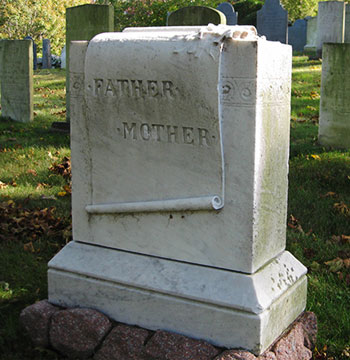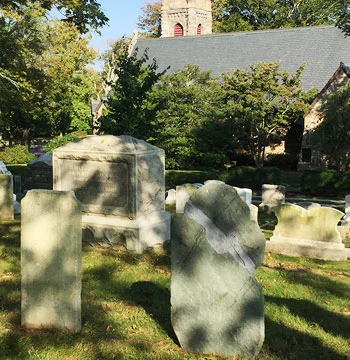Woods Hole Village Cemetery
Location: 13 Church Street, Woods Hole MA 02543
Applicant: Church of the Messiah
Allocation: $77,188
Year/Article: November 2010, A38
The oldest legible gravestone in the Woods Hole Village Cemetery, the second oldest burying ground in Falmouth, is dated 1788, that of Fanny Parker, three years and nine months of age. Before 1786, Falmouth residents were buried in the Old Burying Ground in Falmouth center. The 206 gravestones tell the history of Woods Hole Village, and the cemetery resides within the Woods Hole Historic District. The last grave in the historic Village Cemetery is dated 1984.
The first Woods Hole church, built in 1852 specifically adjacent to the Burying Ground, was transferred to the Church of the Messiah in 1903, which continues to serve as caretaker for the cemetery, providing grave cleaning and maintenance annually. The Village Cemetery holds the graves of generations of Woods Hole families dating from the earliest settlers, people who worked in the fields and on the water, carpenters and gardeners of the estates, and wealthy patrons who developed, invested and vacationed in the area. The larger cemetery continues to hold the graves of Woods Hole individuals and families, including Nobel Laureates and other renowned scientists from the Marine Biological Laboratory (MBL), the Woods Hole Oceanographic Institute, and the National Oceanographic and Atmospheric Administration, especially the National Marine Fisheries Service.
In 2010 the Church of the Messiah applied to the CPFund and was granted $77,188 in support of an $83,000 Phase II project for additional restoration and preservation of the original Village Burying Ground as laid out before 1799. Phase I of the preservation effort had begun in 2008 under a volunteer conservator, members of the Falmouth Genealogical Society, and other community volunteers. Also participating in this work were individuals required to give public service under direction of Barnstable Court System as well as prisoners under Barnstable County Sheriff’s Office.
Phase II required the services of a professional conservator for work on the very delicate slates, brownstones, and marbles. The oldest gravestones were made of slate, which was said to have come as ballast in ships from England. It is believed that the brownstone was shipped back from fertile land in the Connecticut River Valley. The majority of the stones were of marble, which had begun to “sugar” from acidic rain. Many of the stones were wobbling and required resetting. During the work a number of miniature marble headstones, used to mark babies’ burials, were discovered and preserved in a special lot.
Additional support for the Phase II work came from the Woods Hole Foundation, the Friendship Fund, and community volunteers. The Falmouth Genealogical Society produced a catalogue of the Burying Ground with photography and genealogical research (available here).
Work was completed in 2013.




